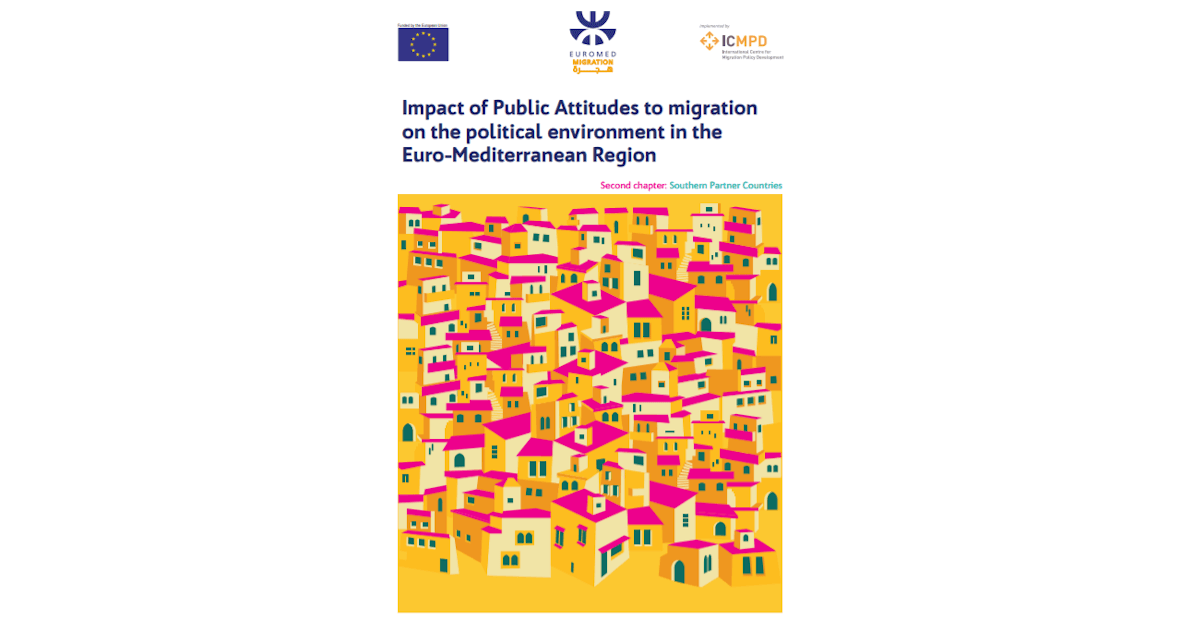This is the second of three chapters for the report entitled ‘Impact of Public Attitudes to migration on the political environment in the Euro-Mediterranean Region’.
The report forms part of the Phase III EUROMED Migration Communications Study. This report follows Phase II EUROMED Migration Communications Study, entitled “Public attitudes on migration: rethinking how people perceive migration”, which demonstrated that attitudes to migration in the Euro-Mediterranean region seem to have remained fairly constant over time, while the importance of the issue to individuals has changed.
This chapter overviews public attitudes to migration in Southern Partner Countries (SPCs) and considers
their effects on migration politics and policies in the region over the past 20 to 30 years. Overall, the quantitative overview of attitudes in the SPCs offers a number of clear patterns:
• A large majority (at least 63 per cent) of citizens in almost every country considered display positivity or indifference when asked about general xenophobic attitudes to immigrants.
• However, a significant minority offer explicitly xenophobic attitudes to immigrants in all but one country, with between 15 per cent and 38 per cent stating they would not like to have an immigrant as a neighbour.
• Attitudes to refugees tend to differ from those of other immigrants, with either greater positively or negatively depending on country context and between 9 per cent and 26 per cent stating that they would not like to have them as neighbours.
• By contrast, in every country and across time, the vast majority (75 – 99 per cent) of citizens display anti-immigration attitudes regarding the labour market, with in some cases almost unanimous belief that employers should give priority to citizens.
• However, attitudes to both immigrants as neighbours and as participants in the labour market are in many cases becoming more positive over time.
• When North Africans are asked to choose between free movement of persons between their countries, on the one hand, or government control over intra-North African migration, on the other, they are divided roughly equally in each country, with a slight majority in favour of government controls.
• Despite significant anti-immigration sentiment, immigration remains a low salience issue in every country considered (with the recent exception of the issue of Syrian refugees in Jordan and Lebanon).
• It is the low salience of immigration that most differentiates the politics of the SPCs from European
Union Member States (as shown in Chapter 1 of this report).
• Low salience means that policy-makers—regardless of regime type—are likely to feel relatively little public pressure when creating migration policy, giving them significant flexibility.
• It also means that NGOs and civil society organisations are likely to have increased influence on policy, rather than the public at large, which we provide some evidence to suggest is indeed the case in Tunisia and Morocco.
• In Jordan and Lebanon, by contrast, increased salience of Syrian refugees as a political issue has led to tightening government restrictions.
• This is not to say that SPC publics do not see migration as an important issue outright, but rather that they clearly consider it relatively less important than economic, administrative and security issues, and it is these issues that policy-makers are most likely to feel pressure to act on.
• We also find some evidence that emigration is considered an exceptionally large problem in SPCs. However, we also find a lack of data regarding attitudes to emigration, as in other regions.
Read the full chapter by James Dennison and Mohamed Nasr.
